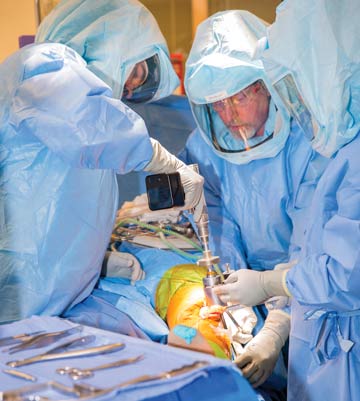Orthopedic surgeons are like star athletes, engaging in a highly physical profession that takes a significant toll on their bodies. David Ruch, MD, an orthopedic surgeon at Duke Health in Durham, N.C., began operating in 1988. "Neck arthritis or pinched nerves are a few common injuries among orthopods," he says. "We stand and lean forward at the neck to operate."
While that's true across many specialties, ergonomic issues with power tools can be problematic in orthopedics. The tools are loud. They vibrate. They kick back.
"The things that cause the most difficulties for us are reamers, which have a fair amount of torque in order to be able to core out hard bone to place implants during joint replacement procedures," says Dr. Ruch. "If the reamer hits a hard piece of bone, it'll spin the drill back and twist your wrist."
Dr. Ruch says orthopods pick up injury mitigation lessons throughout their careers. "You learn what not to do," he says. "You learn to start out slow with the reamer to give the bone a chance to widen without generating as much torque."
Then there are the power saws. "They have a lot of vibration," says Dr. Ruch, who also acknowledges that the decibel levels of power tools could have an impact on hearing over time, an issue he says requires study.
Orthopedic surgeons are powerless without power tools, and as their understanding of and demand for proper ergonomics evolves, new products in the category are striving to accommodate those needs. The latest drills and saws are designed to address surgeon comfort, usability and safety.
Ergonomic grips allow surgeons to maintain a neutral wrist position, which reduces the risk of them developing carpal tunnel injuries. Power tools are also available in lighter weights, which can reduce hand and wrist fatigue while enhancing the surgeon's maneuverability in the operating space. Textured areas on handles provide firmer grips for surgeons during intense drilling, sawing and cutting.
The latest generation of drills and saws come with wider ranges of torque and speed, providing surgeons with more precise control to make accurate cuts with less physical exertion in a variety of bone densities. Oscillating saw tips reduce noise and vibration, the cumulative effects of which can negatively impact the surgeon's health.
Some design features — such as reduced sparking to prevent surgical fire hazards and accidental burns — are meant to avoid more significant harm. Others are intended to lessen the mental strain of surgeons: Enhanced power supplies enable more consistent and reliable use with longer run times, and keyless drill chucks prevent loosening through secondary locking mechanisms, giving surgeons more confidence when drilling into dense bone.
.svg?sfvrsn=be606e78_3)

.svg?sfvrsn=56b2f850_5)